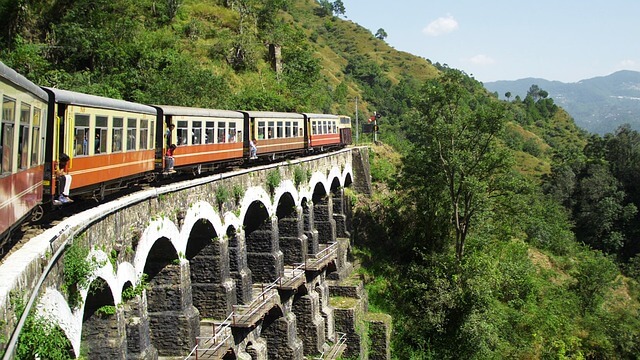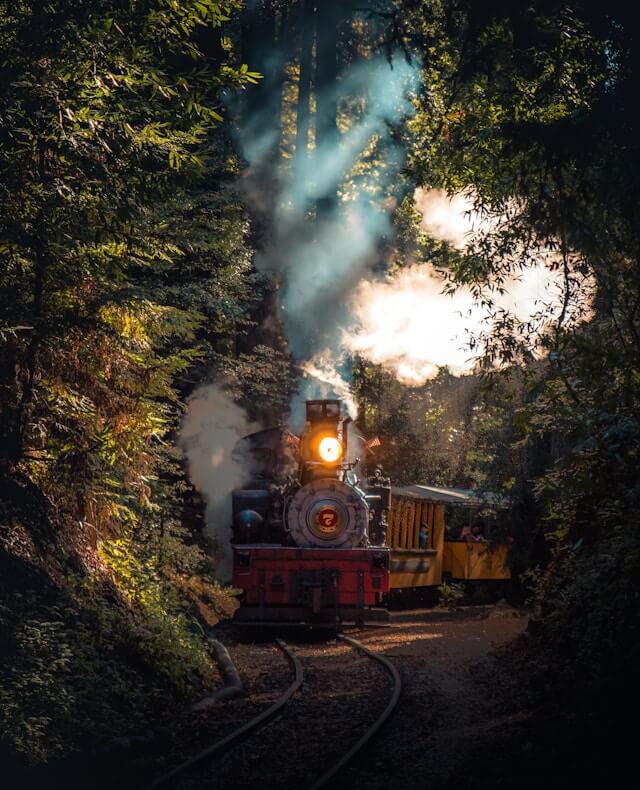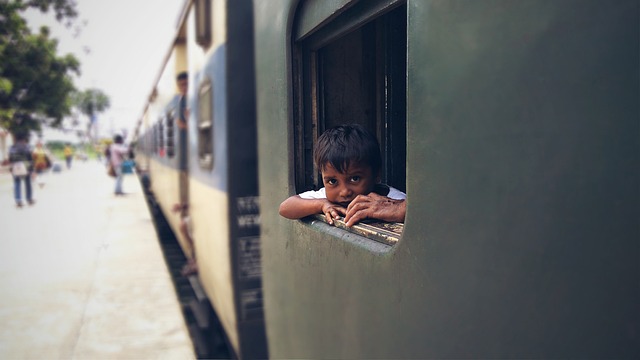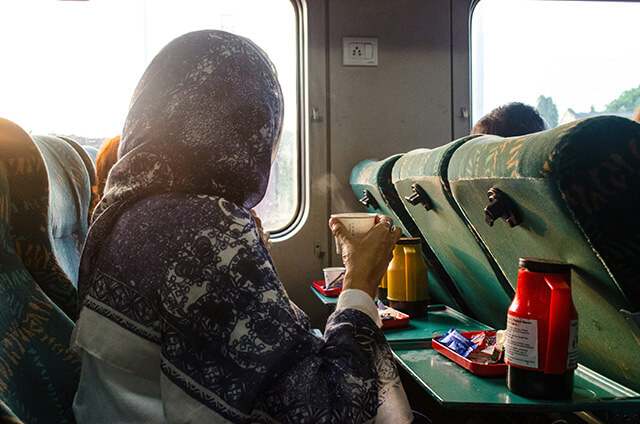Train Journeys in India
By Shruti Viswanathan

|
Despite the astonishing amount of travel literature on India, very little has been written about the massive, lumbering system that connects its various limbs: the railways. To truly traverse India, you must travel by train. While traveling by train, differences of class, caste, and religion are, often reluctantly, suspended. Watch people on a train closely enough, and the culture and ethos of various parts of India can be easily discerned. Trains also mirror the inexplicable and often overly frustrating mystery that is this nation. Walk into most trains today, and they will be equipped with charging points for your cell phones, laptops, and other electrical paraphernalia. Walk into a toilet to answer nature’s call, and you will find that your toilet consists of a hole in the compartment with minimal water supply. How a country that is at the cutting edge of technological innovation, produces some of the best-educated people in the world, and even managed to send a man to the moon cannot grasp the simple art of sanitation in railways is a question that has been at the forefront of my mind ever since I can remember.
However fascinating the unsolved mystery of portable sanitation in India may be, let’s set it aside for now and turn to something just as intriguing but less inexplicable: the interactions between the various people on a train. The railways and the military remain one of the few places of proper social integration in India. You can’t choose who you travel with on a train. Yet, you are stuck with them for hours (sometimes days) in a cramped little space, sharing some exhilarating and exasperating moments. I shared my coach with five others the last time I was on a train. Within half an hour of departure, the gentleman next to me loudly spoke to his father on the phone, unconcerned that the entire bay was now privy to his career plans and particular (disturbing) elements of his private life. Next to him was his beautiful and somewhat shy wife. I could tell they were newly married because of the white and red bangles that swallowed her arm. Next to them was a stern old lady who wrinkled her nose in distaste at the loud conversation. This feat was remarkable as she had it simultaneously buried in a Tamil magazine. A nervous and tense middle-aged couple rounded the sextet. Unsurprisingly, upon further conversation, I discovered that the newlyweds were Punjabis from Delhi. As loud as they were, they were equally warm, hospitable, and willing to talk. Their exuberant warmth, instant friendliness, bold, slightly pushy manner, and disregard for others’ eardrums reflect most Punjabis's ethos. The elderly Tamil aunty was more challenging to read, but I think she felt a sense of kinship with me: us against those loud north Indians. Reserved, a little stuck up, and very wary of strangers, she fit the Tamil Brahmin stereotype to a T. Once she warmed up, though, she was charming. Much to our collective relief, she offered to wake us all up when Bangalore Cantonment arrived and, with military efficiency, ensured that the bedding was evenly distributed amongst all six of us.

|
The middle-aged couple proved to be the toughest to crack. It is a sad fact that religious and class barriers are often the most imposing in India. Consequently, this lower middle-class Christian couple from Andhra was timid in their interaction with others. In addition, the wife was obviously unwell, on medication, and quite demanding in her pain-induced haze. The husband was embarrassed and barely uttered a word. Yet, despite all our differences, we came together to help lift the lady, switch off the lights, ensure she had water, and offer our unhesitating help at various points during the night. Trite as it may sound, most parts of India are bound by this shared sense of "Indian-ness" despite gaping differences. It is challenging to describe and defies all logic — but it is there.
As you travel from one end of the country to the other, a distinct change in food, flora, and fauna, songs that the beggars sing, and even the subtle mannerisms of people become apparent. While traveling from the more polite and stand-offish South to the bold and open-hearted North, my friends and I were again struck by this difference. Minding your P’s and Q’s in all interactions in the South is essential. Politeness is respected to the point of absurdity. (I once thanked an auto driver in Bangalore after having a massive fight with him regarding his errant meter.) Thus, the “chai-wallah” (tea boy) who served us at the beginning of the journey accepted our “thank-you” with an accepting nod and nothing more. We slowly crossed the plateau and moved into the Hindi heartland. Grateful for our daily caffeine fix, we thanked the new “chai-wallah,”’ only to discover that he was a little startled and at a loss to respond to this outpouring of gratitude. After a moment’s pause, he smiled understandingly and informed us that we were now in the North and didn’t have to say thank you.
While the lush and varied view that an Indian train offers is unparalleled, I must admit that my favorite bits of the entire experience are the train stations. Crowded, noisy, and invariably smelly, they bring a wealth of emotions and food. Take in the air near an incoming station containing waiting relatives, and you can almost feel the waiting moods: excitement, eagerness, chaos, joy, and above all, a sense of anticipation. Waiting on these platforms are estranged family members, fathers eager to receive their married daughter and grandkids, a harried husband waiting for his newlywed wife, uncles, and grandfathers coming to pick up their nephews and nieces fresh from their first train ride alone, and a plethora of other complicated relations that I cannot begin to describe. I have primarily excluded waiting women from the platform because they prepare the massive homecoming feast for the guest of honor. Gender roles are well-defined: The man’s job is to navigate the long journey to the station and pick up the suitcases while the woman labors in the kitchen.

|
And this brings us to what I have wanted to talk about for some time: the train station food. Growing up, we traveled long from Bangalore to Delhi during the summer. Why my normally sane parents thought that leaving pleasant, mild-weathered Bangalore for the punishing, sweltering heat of Delhi at the peak of summer was a good idea is beyond me. But we made this senseless journey with much excitement to boot. Watches, sun-dials, kilometer markings, and other measures of time and distance that man(woman)kind has spent considerable energy inventing were of no consequence to us. The actual flags of our progress along the journey were the different types of food we procured: the mango halwa and spicy condiments in Andhra; sour, unripe mangoes at some indeterminate village in Maharashtra; motichoor ladoos and other exotic North Indian sweets in Madhya Pradesh; the pedas at Agra; the rasagullas in breakable matkas in Kolkatta (while the last stop is not on the Bangalore-Delhi line, the succulent rasagullas and the joy derived from breaking the brittle matkas it is too cherished memory to overlook), and the multi-colored candies at nearly every station. Imagine two precocious, sugar-high kids in a tiny parcel of space on a train and the trouble they can create. The fact that my brother and I suffered no bodily harm during any of these journeys affirms my faith in the inherent goodness of the Indian public. Each station was awaited with a fervent expectation of the eatables we would be allowed to pig out on. While scrupulous about hygienic foods on most occasions, my mother would let us binge on train rides.

|
And that encapsulates the mystical, other-worldly feel of train journeys. The rules don’t apply; you are temporarily shorn of responsibilities and disconnected from the outer world (even the Moghuls of the internet and cellular age have been unable to pierce this shell with much success, and I would be thrilled if it stayed that way). As you live in limbo for the train journey, a strange sense of freedom and carelessness prevails. The other highlight of our trip was waving madly to little kids in small villages across the journey, who returned our greeting with equal exuberance.
Unfortunately, the railways are slowly being replaced by their counterparts in the air and on the road. Don’t get me wrong, the sheer volume carried by the Indian railways (over 20 million passengers a day) is still mind-boggling. But the diversity of people in these journeys, especially the longer ones, is slowly whittling down. Fewer tourists will embark on, much less drag their young children on a 40-hour (often longer) train ride across the country in a non-A.C. compartment. While some might (my 10-year-old self included) breathe a sigh of relief at this, I regret that so many others are missing out on this wonderful method of enjoying the astounding diversity of this nation, her people, and the tenuous thread of unity that binds them all. They will never be aware of missing this great way of experiencing and understanding India.
Train journeys in India require a sense of innocence, optimism, patience, excitement, and even resignation to be fully enjoyed. Be ready for a bumpy, wonderful journey that will evoke either great love and memories or a passionate loathing. It’s not easygoing, but then again, neither is the country.
Shruti Viswanathan is a lawyer by profession and in her spare time freelances as a food and travel writer. She freelances for the Hindu, one of India's leading newspapers. She has written for lifestyle magazines and other publications in India. She hopes to take this up professionally in the future.
|
